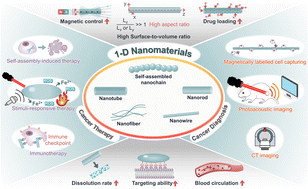One-dimensional (1-D) nanomaterials possess unique shape-dependent phyicochemical properties and are increasingly recognized as promising materials for nanotechnology. 1-D nanomaterials can be classified according to their shape, such as nanorods, nanotubes, nanowires, self-assembled nanochains, etc., and have been applied in electronics, photonics, and catalysis. The biological characteristics of 1-D nanomaterials, including high drug loading efficiency, prolonged blood circulation, the ability to capture cancer cells, unique cellular uptake mechanisms, efficient photothermal conversion, and material tunability, have aided in extending their potential to biomedical applications, particularly in cancer therapy and diagnosis. This review highlights a novel perspective on emerging 1-D nanomaterials for cancer therapy and diagnosis by introducing the definition of 1-D nanomaterials, their shape-dependent physicochemical properties, biomedical applications, and recent advances in cancer therapy and diagnosis. This review also proposes unexplored potential nanomaterial types and therapeutic applications for 1-D nanomaterials. In particular, the most significant and exciting advances in recent years, including ultrasound-enabled sonodynamic therapy, magnetic field-based therapy, and bioresponsive 1-D nanomaterials for intracellular self-assembly in situ, are discussed along with novel therapeutic concepts, such as piezoelectric 1-D nanomaterials, nanozyme-based nanomedicine, and others.

